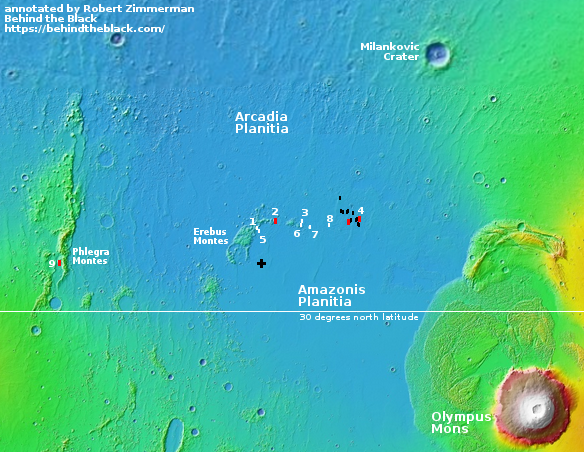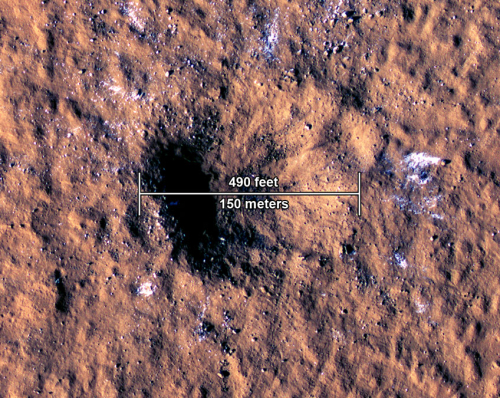Monitoring the largest recent impact detected by InSight’s seismometer

Cool image time! On December 24, 2021 the seismometer of the Mars lander InSight detected a four magnitude earthquake, the largest detected up until then. Because its nature suggested that it had been caused by an impact, not an internal shifting, the science team for Mars Reconnaissance Orbiter (MRO) immediately started searching for new impact craters in the area of Mars where the data suggested the quake came from.
Two months later they found it, in the northern lowland plains just south of the prime landing zone chosen by SpaceX for its Starship spacecraft. The black cross on the overview map to the right indicates the position. The four red spots are the prime Starship landing sites. The white dots indicate other locations considered. The black dots were images taken for a proposed Dragon landing. This impact is thus only about 100 miles away from the nearest possible Starship landing spot.
This region is of interest because the data suggests it has a lot of near-surface ice. This impact confirmed this hypothesis, as that first image to the right showed numerous ejecta blocks of ice surrounding the crater.
Since that 2022 first image, scientists have been using MRO to not only search and find secondary nearby craters produced by ejecta from this impact, they have been monitored the crater for changes over time. Below are three pictures showing the crater’s evolution across three seasons of Mars. The leftmost picture is the initial discovery image, taken February 27, 2022. The middle image was taken on October 11, 2022. The rightmost photo is the most recent of all, taken on June 30, 2025. All three images have been rotated, reduced, and cropped to post here. I have also lightened the two on the left to match the right most image, to make comparison more easy.

For original images go here, here, and here.
Note how the overall impact splatter is darker in the winter. I could guess that this is related to dry ice snow, but that is not to be relied upon. At 35 degrees north latitude this might be too far south for dry ice to fall as snow. Note too how the central splatter closest to the impact has darkened with time.
Explaining these changes is above my pay grade. The most recent image however is labeled by the science team “Monitoring Large Icy Crater”, so they clearly believe the features here are icy in some way.
On Christmas Eve 1968 three Americans became the first humans to visit another world. What they did to celebrate was unexpected and profound, and will be remembered throughout all human history. Genesis: the Story of Apollo 8, Robert Zimmerman's classic history of humanity's first journey to another world, tells that story, and it is now available as both an ebook and an audiobook, both with a foreword by Valerie Anders and a new introduction by Robert Zimmerman.
The print edition can be purchased at Amazon or from any other book seller. If you want an autographed copy the price is $60 for the hardback and $45 for the paperback, plus $8 shipping for each. Go here for purchasing details. The ebook is available everywhere for $5.99 (before discount) at amazon, or direct from my ebook publisher, ebookit. If you buy it from ebookit you don't support the big tech companies and the author gets a bigger cut much sooner.
The audiobook is also available at all these vendors, and is also free with a 30-day trial membership to Audible.
"Not simply about one mission, [Genesis] is also the history of America's quest for the moon... Zimmerman has done a masterful job of tying disparate events together into a solid account of one of America's greatest human triumphs."--San Antonio Express-News

Cool image time! On December 24, 2021 the seismometer of the Mars lander InSight detected a four magnitude earthquake, the largest detected up until then. Because its nature suggested that it had been caused by an impact, not an internal shifting, the science team for Mars Reconnaissance Orbiter (MRO) immediately started searching for new impact craters in the area of Mars where the data suggested the quake came from.
Two months later they found it, in the northern lowland plains just south of the prime landing zone chosen by SpaceX for its Starship spacecraft. The black cross on the overview map to the right indicates the position. The four red spots are the prime Starship landing sites. The white dots indicate other locations considered. The black dots were images taken for a proposed Dragon landing. This impact is thus only about 100 miles away from the nearest possible Starship landing spot.
This region is of interest because the data suggests it has a lot of near-surface ice. This impact confirmed this hypothesis, as that first image to the right showed numerous ejecta blocks of ice surrounding the crater.
Since that 2022 first image, scientists have been using MRO to not only search and find secondary nearby craters produced by ejecta from this impact, they have been monitored the crater for changes over time. Below are three pictures showing the crater’s evolution across three seasons of Mars. The leftmost picture is the initial discovery image, taken February 27, 2022. The middle image was taken on October 11, 2022. The rightmost photo is the most recent of all, taken on June 30, 2025. All three images have been rotated, reduced, and cropped to post here. I have also lightened the two on the left to match the right most image, to make comparison more easy.

For original images go here, here, and here.
Note how the overall impact splatter is darker in the winter. I could guess that this is related to dry ice snow, but that is not to be relied upon. At 35 degrees north latitude this might be too far south for dry ice to fall as snow. Note too how the central splatter closest to the impact has darkened with time.
Explaining these changes is above my pay grade. The most recent image however is labeled by the science team “Monitoring Large Icy Crater”, so they clearly believe the features here are icy in some way.
On Christmas Eve 1968 three Americans became the first humans to visit another world. What they did to celebrate was unexpected and profound, and will be remembered throughout all human history. Genesis: the Story of Apollo 8, Robert Zimmerman's classic history of humanity's first journey to another world, tells that story, and it is now available as both an ebook and an audiobook, both with a foreword by Valerie Anders and a new introduction by Robert Zimmerman.
The print edition can be purchased at Amazon or from any other book seller. If you want an autographed copy the price is $60 for the hardback and $45 for the paperback, plus $8 shipping for each. Go here for purchasing details. The ebook is available everywhere for $5.99 (before discount) at amazon, or direct from my ebook publisher, ebookit. If you buy it from ebookit you don't support the big tech companies and the author gets a bigger cut much sooner.
The audiobook is also available at all these vendors, and is also free with a 30-day trial membership to Audible.
"Not simply about one mission, [Genesis] is also the history of America's quest for the moon... Zimmerman has done a masterful job of tying disparate events together into a solid account of one of America's greatest human triumphs."--San Antonio Express-News



1> Any idea how deep the crater is?
2> How often does Mars take an impact of this size or larger, relative to Earth? I’d think our atmosphere would give us a little more protection, though it is likely that whatever produced this would probably make it all the way to terra firma here. if it came our way
And, is it an impact crater … or was it produced by the accidental fizzle of an Illudium Q-36 Explosive Space Modulator? :)
Jester Naybor: It’s only about 70 feet deep.
As for the impact rate, I’ve read about it somewhere but don’t remember any details. It isn’t gigantic, but it does produce new small craters periodically that MRO captures and researchers study.
Jester:
Is that the upgrade to the Illudium Q-35 Space Modulator?
“Haredevil Hare” (1948
https://youtu.be/lTeeq3RX2PE
(3:14)
Dave, I don’t know … the Q-36 is the only model that I’ve seen deployed.
In this case, obviously there was not the specification-compliant Earth-shattering KABOOM!
Seriously, though … is having a few hundred objects capable of making significant impact craters hitting Mars each year, as a couple of studies have presented, a significant threat to colonization of Mars?
Or, can defenses be put up to handle the vast majority of those threats? A directed-energy “Red Dome” system to break up the basketball-size-or-larger objects before they hit?
It might be just as well Starship was delayed.
The vertical caves–maybe have Starship land in one of them after an automated rover levels it out.